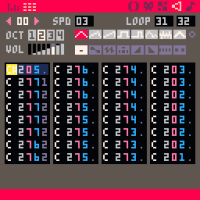
So, in PICO-8, each channel can only play one note at a time. There is technically a way to add hardware echo, but it's undocumented and pretty inflexible; it does one thing and that's it.
That said, there's actually no rule that a melody has to be contained in a single SFX channel.
 It's not a difficult technique, just a bit tedious: in essence, one composes music with instruments that tail off in volume (in this case, first within the custom SFX instrument shown to the right, and then further in the SFXes where the instrument is played), decides how many SFX channels to dedicates to the piece, and then starts each note in each channel in turn, giving each previous note as long as possible to tail off while the others are playing. In the example up top, the first channel comes in on the first line, the second on the second, the third on the third, and then the fourth waits a moment and comes in on the fifth.
It's not a difficult technique, just a bit tedious: in essence, one composes music with instruments that tail off in volume (in this case, first within the custom SFX instrument shown to the right, and then further in the SFXes where the instrument is played), decides how many SFX channels to dedicates to the piece, and then starts each note in each channel in turn, giving each previous note as long as possible to tail off while the others are playing. In the example up top, the first channel comes in on the first line, the second on the second, the third on the third, and then the fourth waits a moment and comes in on the fifth.
(If one note interrupts the tail of a prior one - cuts it off before it fully fades out - it's not a big deal. After all, this is the moment when the note is the most quiet, and therefore least noticeable and most easily drowned out by, say, the new note that just started playing.)
Where we've really been using this technique is in imitating string instruments with a lot of sustain, like guitars or maybe harps? It's a cool sound, anyway.